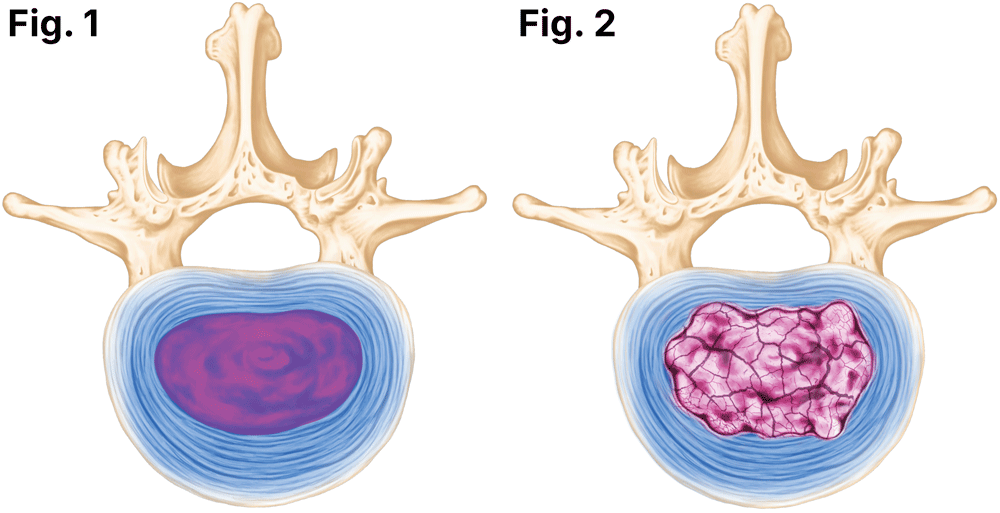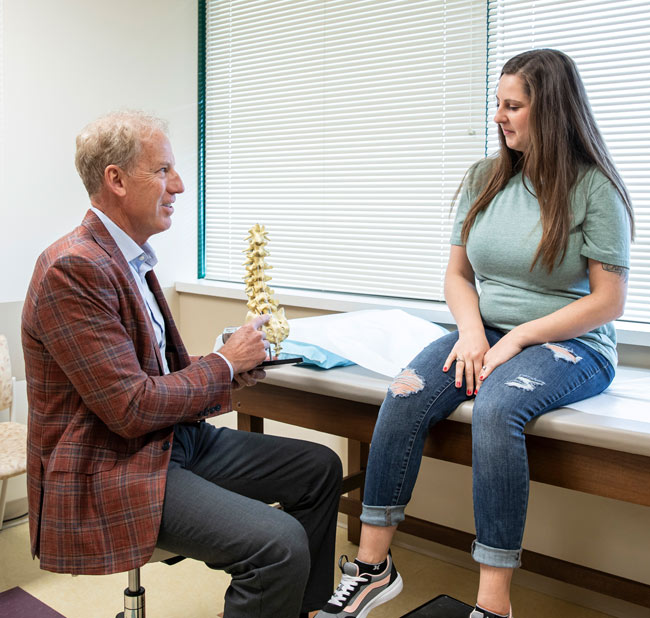If you’ve been living with degenerative disc disease and have exhausted non-surgical treatments, you know how frustrating the search for relief can be. If steps like physical therapy and steroid injections have only brought short-term relief (or none at all), you’re probably wondering what else, short of surgery, is an option. That’s where the VIA Disc NP procedure comes in.
This minimally invasive treatment is designed to repair rather than mask disc-related pain by restoring lost disc height and hydration. In this post, Andrew M. Davisson, MD, an interventional pain specialist at Henry Community Health who performs VIA Disc NP, explains who benefits most from the procedure and when he recommends it as part of a customized care plan to treat disc degeneration’s root cause.
Keep reading for his insights on how doctors make decisions about VIA Disc NP candidacy, what recovery looks like after getting the injection (including how long results last), and the benefits and drawbacks to consider if you’re weighing it against other degenerative disc treatments for meaningful chronic spinal pain relief.
Can anyone with degenerative disc disease undergo the VIA Disc NP procedure?
VIA Disc NP isn’t the right option for every patient. According to Dr. Davisson, the ideal candidate has persistent disc-related low back pain that hasn’t improved despite a solid trial of non-surgical care. Their medical history and physical examination suggest that the disc itself is the primary source of pain. On MRI imaging, he looks for signs of disc degeneration at the levels where you’re experiencing pain, while also checking that the spine is stable and there aren’t large herniations pressing on nerves.
“Spines are complicated. There are a multitude of things that can create pain, from issues with discs and problems in the vertebrae themselves to even arthritis. So it’s my job to hear your story, examine you, see your imaging, and figure out what’s happening to recommend the most effective treatment.”—Dr. Andrew Davisson
When to wait—or consider trying something else
The VIA Disc NP procedure may not be the right fit for everyone with back pain. Dr. Davisson explains that certain conditions require a different approach or different timing.
“If a patient’s primary concern is sciatica, this is not the procedure for them,” says Dr. Davisson. “VIA Disc NP is not for neuropathy. It’s not for nerve pain down your leg. VIA Disc NP is for chronic low back pain from degenerative disc disease that hasn’t resolved with more conservative measures.”

In other words, if you’re dealing mainly with pain shooting down your leg or arm—what doctors call radicular pain—the VIA Disc NP procedure likely isn’t your best option. The same goes for patients with suspected or confirmed infections, severe or multi-level spinal instability, or progressive neurological problems that point toward the need for surgical evaluation.
Large disc herniations with obvious nerve compression typically need a different treatment approach. Significant medical conditions that increase procedural risk or an inability to participate in post-procedure activity progression may also make VIA Disc NP less suitable.
Sometimes, the timing for trying VIA Disc NP just isn’t right yet. If nerve-related leg or arm pain dominates your symptoms, Dr. Davisson might recommend trying an epidural steroid pain injection to calm inflammation and create a greater window for rehabilitation.
If your lower back pain appears to be more clearly disc-driven and persists despite these measures, that’s when the VIA Disc NP procedure becomes a more fitting consideration.
An overview of VIA Disc NP pros and cons
The potential benefits of the VIA Disc NP for treating degenerative disc disease can be significant. Many patients experience fewer painful flares, sleep better, and find everyday activities (such as sitting, standing, and walking) much easier. Some patients even find themselves returning to activities they’d given up on because their symptoms had gotten so bad.
For Dr. Davisson, success means addressing the root cause of his patients’ pain rather than just providing treatment solutions that only temporarily mask symptoms. “When you have a flat tire, your car won’t function right and you won’t get good gas mileage until you refill it,” says Dr. Davisson. “The same is true for a degenerated disc. We can do other injections to treat the symptoms caused by disc degeneration, or we can blow up your tires using VIA Disc NP, which will actually fix the root cause of your problem.”

Great results, while common, aren’t guaranteed. What recovery looks like will vary from person to person. There is no absolute set of improvements that every patient can expect to achieve after having a VIA Disc NP procedure.
“Anytime you’re doing any kind of intervention, there are always risks,” says Dr. Davisson. “I always make sure patients are aware that there is a small risk of potential bleeding, infection, and nerve injury.” Still, at HCH—because its team is highly trained, experienced, and uses X-ray guidance—patients have had “excellent outcomes with next to no side effects or adverse events” after VIA Disc NP.
Recovery from a VIA Disc NP procedure
The most common questions patients ask are related to what life looks like after the procedure. The good news is that recovery happens in stages, and most patients can return to normal activities relatively quickly.
Days 1–3: “Taking it easy”
“The injection only takes about five minutes,” says Dr. Davisson, who performs it using X-ray guidance to ensure precise placement. “You’ll walk in and walk out the same morning.”
In the first few days after your VIA Disc NP procedure, it’s totally normal to experience a little bit of soreness at the site on the back where you got your injection. You’ll want to minimize physical activity during this initial period, sticking to simple things like short walks around your home or neighborhood.
“It’s fine to do routine stuff, as long as it’s nothing too strenuous,” says Dr. Davison. “You’ll have three days of kind of taking it easy and then you’ll be back to your routine—even if that means you work in construction or at an assembly-line type job where you’re lifting repeatedly.”
Days 4–14: Building momentum
During this phase of your VIA Disc NP procedure recovery, you’ll gradually increase your walking distance and work on guided mobility exercises, as advised by your care team.
This is also the time when many patients begin strengthening activities again or progress to the next level in their existing physical therapy programs.
You’ll likely notice that you’re starting to have fewer “bad days” because of your degenerative disc disease, and you should also expect to find it easier to sit or stand for more extended periods without discomfort.
Day 15 and beyond: Getting back to your routine
Everyone’s recovery timeline will vary slightly, but by this period, most patients experience noticeable benefits from undergoing the VIA Disc NP procedure, and many report significant improvements in challenges such as getting quality sleep.
Remember that general milestones matter more than hitting exact calendar dates. Your body’s response to the VIA Disc NP procedure will be unique to you. Your specialist will work with you to adjust expectations and guidance as needed.
Research on the effectiveness of VIA Disc NP
Published pilot and prospective studies have shown promising results for patients who receive intradiscal nucleus pulposus allograft (the technical term for VIA Disc NP). These studies report improvements in both pain levels and physical function.
One particularly comprehensive study demonstrates the potential results patients with degenerative disc disease can achieve with the VIA Disc NP procedure, complete with charts and imaging that show improvements in disc height and patient-reported outcomes.
According to data from Vivex Biologics, the company that makes VIA Disc NP, the results can be long-lasting. “The research findings from studies have been promising,” says Dr. Davisson. “There’s clinical data from three to five years out showing 80% of patients won’t need a repeat VIA Disc NP injection in that time frame.” This is significantly different from steroid injections, which often wear off after a few months and need to be repeated regularly.
The VIA Disc NP procedure at HCH
Henry Community Health stands at the vanguard of innovative spine care for non-surgical degenerative disc treatments, offering patients access to the VIA Disc NP procedure when other conservative care options haven’t provided lasting relief. Dr. Davisson and his colleague, Dr. Taylor, have built significant expertise with this approach.
“At HCH, we’ve done more VIA Disc NP injections in our practice than any other location in the state, or—for that matter—in the Midwest.”—Dr. Andrew Davisson
That experience extends beyond clinical practice. HCH is one of only 20 sites nationwide participating in a level one randomized controlled trial for VIA Disc NP. “From New York to California, our practice in New Castle, Indiana, is a part of that clinical trial,” says Dr. Davisson. “Our goal is to bring real-world data, clinical data that’s going to show the effectiveness of this procedure compared to placebo, and ideally convince a broader scope of insurance to approve and cover the procedure that can really help patients with degenerative disc disease.”
Questions to ask at a VIA Disc NP consultation
Walking into a consultation about degenerative disc treatments when you’re in pain and trying to understand complex medical information can feel daunting. Having a few questions prepared in advance to ask your doctor can help you feel more confident before having that conversation and ensure you get the answers you need to make an informed decision about your future care.
If you’re considering the VIA Disc NP procedure, Dr. Davisson recommends starting the conversation with these questions:
- Based on my history, exam, and MRI, do you think my pain is disc-driven?
- Have I done enough to explore non-surgical care options to be considered a good candidate for a VIA Disc NP procedure?
- What milestones should I expect in the first 12 weeks after a VIA Disc NP procedure?
- If I don’t progress as hoped after a VIA Disc NP procedure, what’s the next step?
- For someone like me, what are the main risks of undergoing the VIA Disc NP procedure? How could these risks be reduced?
Talk with an HCH specialist about the VIA Disc NP procedure
Henry Community Health’s Interventional Spine and Pain Management team specializes in helping patients find relief from chronic back pain through both traditional and cutting-edge treatment approaches. At HCH, we focus on providing personalized care that addresses each patient’s unique situation and goals.
“I tell patients I’m looking to do the least amount to get you the ‘most better’ to meet your quality of life and functional goals. I’m never going to tell someone that one specific treatment is their only option.”—Dr. Andrew Davisson
Your primary care provider can help guide you and provide initial treatment recommendations. But a specialist in interventional pain management has specific expertise in degenerative disc treatments. Whether you’re newly diagnosed with degenerative disc disease or you’ve been managing chronic back pain for years, our experts in chronic spinal pain relief can help you determine if the VIA Disc NP procedure is ideal for where you are and where you want to be, or if other treatments—like targeted injections, continued physical therapy, or alternative interventions—might be more appropriate.
When you’re ready to explore whether the VIA Disc NP procedure is a good fit, schedule a consultation to discuss and get the care you need to return to doing more of what you want to do—without being held back by pain.
